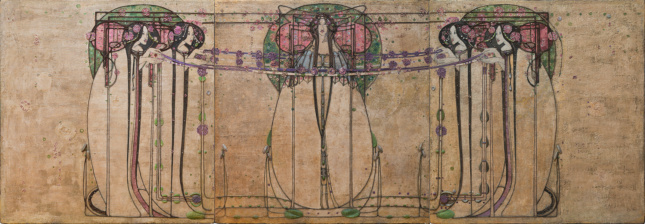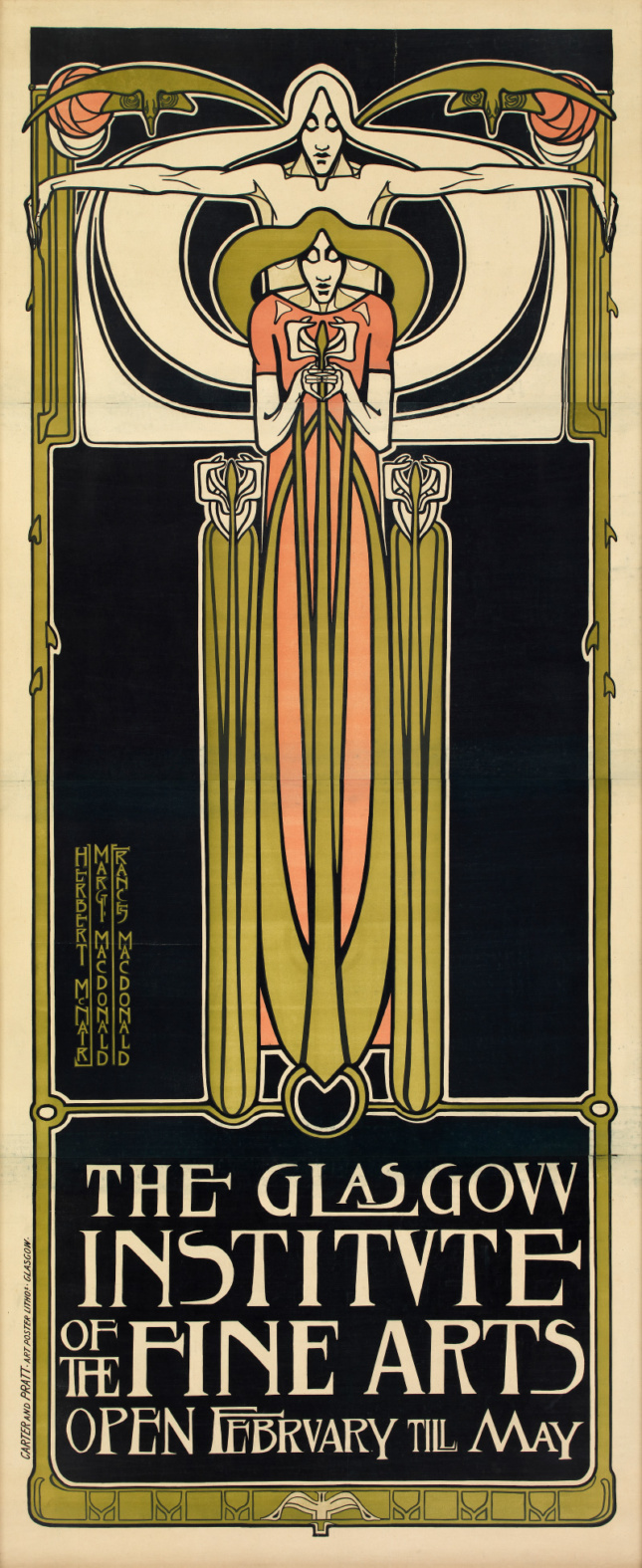Scotland’s most important architect and designer was Charles Rennie Mackintosh (1868–1928). In Nikolaus Pevsner’s 1936 book Pioneers of the Modern Movement, he called Mackintosh “the European counterpart of Frank Lloyd Wright” and a forerunner of Le Corbusier. Like Wright, Mackintosh designed not only buildings but also their furnishings and fixtures.
A new exhibition, Designing the New: Charles Rennie Mackintosh and the Glasgow Style, marks the 150th anniversary of his birth has just opened at Baltimore’s Walters Art Museum. It’s the largest show about the Glasgow Style, one that grew from Mackintosh and his contemporaries at the Glasgow School from the 1890s to 1914, that has ever come to the United States. Many of the 165 objects have never been seen here before. The exhibit draws on the Glasgow Museums collection, with loans from other institutions and private collections.
The exhibit’s purpose is to “put Mackintosh in context,” said curator Alison Brown of the Glasgow Museums. The Glasgow Style was not just Mackintosh “but a big body of people,” she emphasized, including many other architects and designers. Prominent among them were his friend James MacNair, MacNair’s wife Margaret Macdonald, and Macdonald’s sister, Frances, who was Mackintosh’s wife.

Glasgow is “the only city in Britain that created its own version of Art Nouveau,” Brown said. The Glasgow Style was a rejection of historical styles. The bold and distinctive forms were “controversial at the time,” pointed out Brown. She noted that one of the Glasgow Museums’ tour guides often compares the Glasgow Style to the punk rock movement, seeing them as equally radical.
The exhibition’s designers wanted to give viewers a better sense of the buildings referenced in the show. To that end, Designing the New has several videos of the style’s buildings, including exterior details filmed by drones. One of the most detailed videos explores the inside and out of the 1897 Queen’s Cross Church in Glasgow, the only church Mackintosh designed.
Another video highlights several buildings completed by Mackintosh’s contemporaries James Salmon Jr. and John Gaff Gillespie, who designed many Glasgow banks.
While wall labels are important, visitors often skip them. To make the installation meaningful even for visitors who quickly pass through, Brown says the curators and designers chose and located objects “to make visual connections,” to highlight the relationships between them and the evolution of the Glasgow Style.
The show delves into influences on Mackintosh’s early career, including a major cultural exchange between Glasgow and Japan in 1878 that brought Japanese art to the city, and his trip to Italy in 1891. Another influence on the evolution of the Glasgow Style was traditional Celtic culture, which was enjoying a revival during Mackintosh’s lifetime.

Later in his career, Mackintosh visited Vienna and was influenced by the Vienna Secession. The square motifs often used in Vienna Secession designs began to appear in his furniture, and Machintosh’s work also become more streamlined and “more intense,” said Brown. Some of his work prefigures the Art Deco movement.
Countless people with no interest in architecture and design have been exposed to Mackintosh—Brown said his work seems to fascinate film and TV designers. Two high-backed chairs in Designing the New have been reproduced many times. A chair he created for the Argyle Street Tea Room (1898) appeared in films such as Blade Runner, The Addams Family, Doctor Who” and Madonna’s video for the song “Express Yourself.” A chair he designed for Hill House (1905) was in the film American Psycho and an episode of the TV show Babylon 5.
Designing the New: Charles Rennie Mackintosh and the Glasgow Style runs at the Walters through January 5, 2020. It will be at the Frist Art Museum, Nashville, June 26 to September 27, 2020; the Museum of the American Arts and Crafts Movement, St. Petersburg, Florida, October 29, 2020, to January 24, 2021; and the Richard H. Driehaus Museum, Chicago, February 27 to May 23, 2021.
The exhibit is organized by the American Federation of Arts and the Glasgow Museums.
In Baltimore, the Glasgow exhibit is accompanied by From Mucha to Morris: Books of the Art Nouveau, which features 12 books designed by William Morris, Alphonse Mucha, Aubrey Beardsley, and others, drawn from the Walters’ collection.











